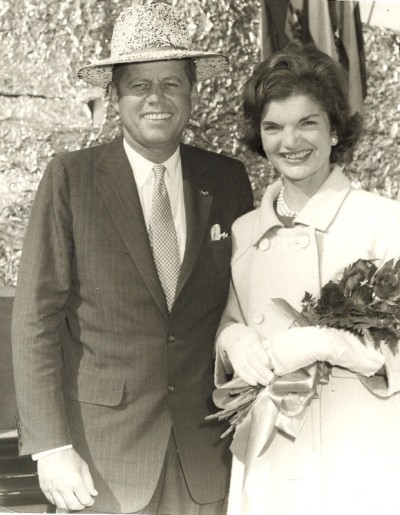John F. Kennedy loved to eat at Howard Johnson restaurants:
Whenever he saw one on the campaign trail, we’d have to stop so he could duck in, order two hot dogs and a soft drink,” said photographer Stanley Tretick, who covered the 1960 presidential campaign for United Press International. Kennedy was the democratic candidate.
Once Tretick almost got a candid shot of Kennedy eating a hotdog. Kennedy was sitting in his car. Tretick aimed his camera but
He [Kennedy] slid under the dashboard so I couldn’t see him,” recalled Tretick. Then Kennedy wolfed down his lunch undisturbed. (1)
Kennedy thought such photographs – politicians eating hot dogs, for example – were “corny.” He cared immensely about his image. Kennedy studiously avoided being photographed eating, drinking, combing his hair, or wearing any one of the endless hats – sombreros, cowboy, Native American headdresses – given to him while on the campaign trail. He generally refused to put on the hats, except a hard hat. Heavy laborers – miners, electricians, factory workers – “went big” for him and he appreciated their acceptance.
THE RICE HAT
Below is the rare photo in which Kennedy looks a little silly. It was taken before he had actually declared his candidacy for president. It was October 1959 and he was Senator Kennedy from Massachusetts. He and his wife Jackie were guests at the International Rice Festival in Crowley, Louisiana. Kennedy was drumming up interest in a presidential run.
Kennedy is wearing a rice hat. I’d like to think that, the next day, Kennedy saw this picture in a local newspaper and thought, “Woah! I’ve got to be more careful when I actually do declare my candidacy! If I look this dopey, I’ll never beat Dick Nixon!” I’d like to think that this picture taught him the lesson he needed to eschew wearing hats in photos that would go viral.

Senator John F. Kennedy and wife Jackie at the Rice Festival, Crowley, Louisiana. October 1959. Reggie Family Archives.
Three years into his presidency and the president’s aversion to wearing hats was legendary. But that didn’t stop the hatmakers from forcing hats on him everywhere he went.
Here’s YouTube footage of John Kennedy refusing to put on a cowboy hat given to him at a Chamber of Commerce breakfast in Fort Worth, Texas, on the last day of his life. He enters the ballroom at 9:45 on the tape and he jovially refuses to wear the hat at 45:45.
In three hours he would be dead. The hat was never found.
(1) Kelley, Kitty. Capturing Camelot: Stanley Tretick’s Iconic Images of the Kennedys. New York: St. Martin’s Press, 2012.






























